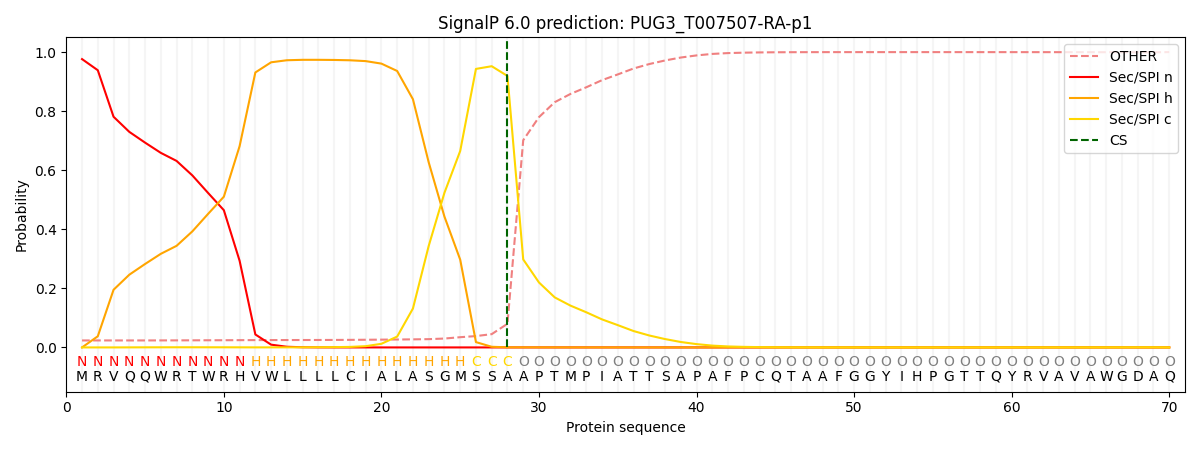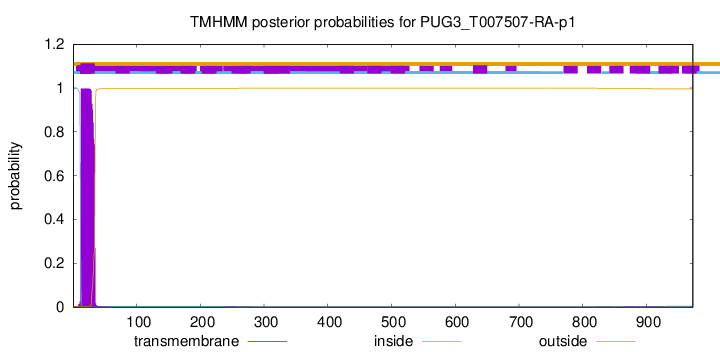You are browsing environment: FUNGIDB
CAZyme Information: PUG3_T007507-RA-p1
You are here: Home > Sequence: PUG3_T007507-RA-p1
Basic Information |
Genomic context |
Full Sequence |
Enzyme annotations |
CAZy signature domains |
CDD domains |
CAZyme hits |
PDB hits |
Swiss-Prot hits |
SignalP and Lipop annotations |
TMHMM annotations
Basic Information help
| Species | Globisporangium ultimum | |||||||||||
|---|---|---|---|---|---|---|---|---|---|---|---|---|
| Lineage | Oomycota; NA; ; Pythiaceae; Globisporangium; Globisporangium ultimum | |||||||||||
| CAZyme ID | PUG3_T007507-RA-p1 | |||||||||||
| CAZy Family | GT71 | |||||||||||
| CAZyme Description | Methyltransferase | |||||||||||
| CAZyme Property |
|
|||||||||||
| Genome Property |
|
|||||||||||
| Gene Location | ||||||||||||
CDD Domains download full data without filtering help
| Cdd ID | Domain | E-Value | qStart | qEnd | sStart | sEnd | Domain Description |
|---|---|---|---|---|---|---|---|
| 226428 | Spy | 1.30e-28 | 598 | 937 | 250 | 577 | Predicted O-linked N-acetylglucosamine transferase, SPINDLY family [Posttranslational modification, protein turnover, chaperones]. |
| 240122 | PA_subtilisin_1 | 1.04e-06 | 45 | 158 | 1 | 112 | PA_subtilisin_1: Protease-associated domain containing subtilisin-like proteases, subgroup 1. A subgroup of PA domain-containing subtilisin-like proteases. The significance of the PA domain to many of the proteins in which it is inserted is undetermined. It may be a protein-protein interaction domain. At peptidase active sites, the PA domain may participate in substrate binding and/or promoting conformational changes, which influence the stability and accessibility of the site to substrate. Proteins into which the PA domain is inserted include the following subtilisin-like proteases: i) melon cucumisin, ii) Arabidopsis thaliana Ara12, iii) Alnus glutinosa ag12, iv) members of the tomato P69 family, and v) tomato LeSBT2. However, these proteins belong to other subtilisin-like subgroups. Relatively little is known about proteins in this subgroup. |
| 238300 | PA | 3.23e-05 | 68 | 159 | 28 | 121 | PA: Protease-associated (PA) domain. The PA domain is an insert domain in a diverse fraction of proteases. The significance of the PA domain to many of the proteins in which it is inserted is undetermined. It may be a protein-protein interaction domain. At peptidase active sites, the PA domain may participate in substrate binding and/or promoting conformational changes, which influence the stability and accessibility of the site to substrate. Proteins into which the PA domain is inserted include the following: i) various signal peptide peptidases including, hSPPL2a and 2b which catalyze the intramembrane proteolysis of tumor necrosis factor alpha, ii) various proteins containing a C3H2C3 RING finger including, Arabidopsis ReMembR-H2 protein and various E3 ubiquitin ligases such as human GRAIL (gene related to anergy in lymphocytes), iii) EDEM3 (ER-degradation-enhancing mannosidase-like 3 protein), iv) various plant vacuolar sorting receptors such as Pisum sativum BP-80, v) glutamate carboxypeptidase II (GCPII), vi) yeast aminopeptidase Y, vii) Vibrio metschnikovii VapT, a sodium dodecyl sulfate (SDS) resistant extracellular alkaline serine protease, viii) lactocepin (a cell envelope-associated protease from Lactobacillus paracasei subsp. paracasei NCDO 151), ix) various subtilisin-like proteases such as melon Cucumisin, and x) human TfR (transferrin receptor) 1 and 2. |
| 239039 | PA_PoS1_like | 9.58e-05 | 72 | 156 | 43 | 121 | PA_PoS1_like: Protease-associated (PA) domain PoS1-like. This group includes various PA domain-containing proteins similar to Pleurotus ostreatus (Po)S1. PoSl, the main extracellular protease in P. ostreatus is a subtilisin-like serine protease belonging to the peptidase S8 family. Ca2+ and Mn2+ both stimulate the protease activity of (Po)S1. Ca2+ protects PoS1 from autolysis. PoS1 is a monomeric glycoprotein, which may play a role in the regulation of laccases in lignin formation. (Po)S1 participates in the degradation of POXA1b, and in the activation of POXA3, (POXA1b and POXA3 are laccase isoenzymes), but its effect may be indirect. The significance of the PA domain to PoS1 has not been ascertained. It may be a protein-protein interaction domain. At peptidase active sites, the PA domain may participate in substrate binding and/or promoting conformational changes, which influence the stability and accessibility of the site to substrate. |
| 240120 | PA_SaNapH_like | 2.01e-04 | 88 | 122 | 45 | 79 | PA_SaNapH_like: Protease-associated domain containing proteins like Streptomyces anulatus N-acetylpuromycin N-acetylhydrolase (SaNapH).This group contains various PA domain-containing proteins similar SaNapH. Proteins in this group belong to the peptidase M28 family. NapH is a terminal enzyme in the puromycin biosynthetic pathway; NapH hydrolyzes N-acetylpuromycin to the active antibiotic. The significance of the PA domain to these proteins has not been ascertained. It may be a protein-protein interaction domain. At peptidase active sites, the PA domain may participate in substrate binding and/or promoting conformational changes, which influence the stability and accessibility of the site to substrate. |
CAZyme Hits help
| Hit ID | E-Value | Query Start | Query End | Hit Start | Hit End |
|---|---|---|---|---|---|
| 2.60e-127 | 43 | 973 | 42 | 874 | |
| 3.22e-55 | 606 | 973 | 672 | 1023 | |
| 3.69e-51 | 411 | 969 | 406 | 917 | |
| 2.01e-50 | 544 | 969 | 525 | 917 | |
| 2.66e-50 | 544 | 969 | 525 | 917 |
Swiss-Prot Hits help
SignalP and Lipop Annotations help
This protein is predicted as SP

| Other | SP_Sec_SPI | CS Position |
|---|---|---|
| 0.026620 | 0.973342 | CS pos: 28-29. Pr: 0.9192 |

